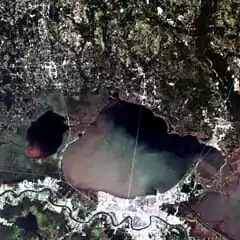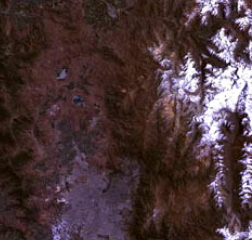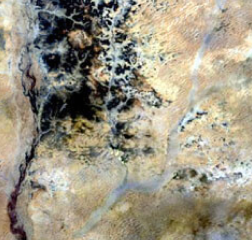Natural Color Band Combination
Computer screens display an image in three different ranges, using a different primary color for each range. When we combine these three images, the result is a color image with the color of each pixel defined by variance in the ratios of Red, Green, and Blue (RGB). A natural color composite image displays a combination of visible red, green and blue bands with the corresponding red, green and blue channels. The natural color composite corresponds to how we usually see the world; vegetation appears green, water from blue to black, and bare earth and impervious surfaces light gray and brown.
Many people prefer true color composites, because colors that seem natural to our eyes are often difficult to discern in detail. Natural color images can be low in contrast and somewhat vague due to the scattering of blue light in the atmosphere.
Since this combination uses visible bands, ground signs appear in colors that correspond with their appearance to the human eye; healthy green vegetation, newly cleaned fields are very light, unhealthy vegetation is brown and yellow, roads are gray, and shorelines are white. This combination of strips provides the greatest water penetration and excellent precipitation and bathymetric information. This combination is also used for urban research.
The color composite of Landsat 5 “3, 2, 1” (Red = 3 channel, Green = 2 channel, Blue = 1 channel).
Interpretation Of Natural Color Band Combination
This is the combination of natural colors, whereby channels of the visible range are used; hence healthy vegetation looks green, cleaned fields – light, unhealthy vegetation – brown and yellow, roads – gray, shorelines – white. This combination of channels makes it possible to analyze the state of water bodies and sedimentation processes, and also estimate depths. This combination is also used for studying anthropogenic objects.
The cuttings and sparse vegetation are poorly detected, unlike the 4-5-1 or 4-3-2 combination. Clouds and snow appear equally white and are therefore difficult to distinguish. It is also difficult to separate one type of vegetation from another. This combination does not distinguish shallow water from soil, unlike the 7-5-3 combination.


